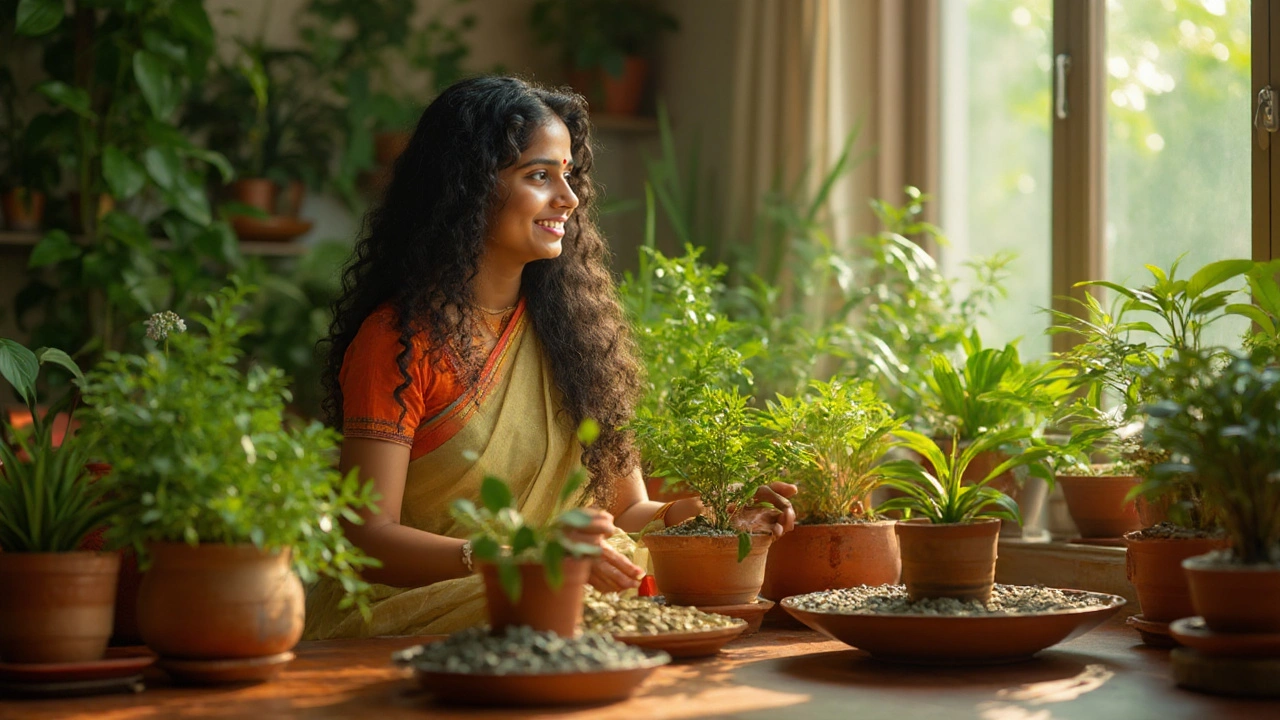You know that feeling when your houseplants start looking a little crispy around the edges, like they miss their rainforest roots? That’s the moment a pebble tray can totally save your green buddies. Most people don’t realize that basic household items—yep, a shallow tray and a handful of pebbles—can change the game for your plant shelf. The science behind it is simple but kind of genius. When water evaporates from the tray, it bumps up the humidity right where your plants hang out. Suddenly, you’re not just someone with a monstera on the sideboard—now you’re running a microclimate operation, and your plants are thriving. Curious why this works so well for certain houseplants, or how to keep it clean? Stick around, there’s a ton to unpack here, plus some mistakes nearly everyone makes (and how you won’t!).
Why Humidity Matters for Indoor Plants
Ever wonder why your calathea curls its leaves or your fern looks sad and dull, even when you water them on schedule? Plants, especially tropical varieties, aren’t dramatic—they just have real needs, and one of the biggest is humidity. Indoor air, blasted by heaters in winter and cooled by AC in summer, can get bone dry. Most houseplants thrive at a sweet spot of 40-60% relative humidity, but most homes barely scrape by at 20-30% sometimes.
The science behind all this starts with plant biology. Plants “sweat” through a process called transpiration. It’s like their own internal evaporative cooler. If the air is dry, water rushes out from leaves too fast, and the plant can’t suck it up from the soil fast enough. That’s when you see crispy leaf tips, stunted growth, and those weird brown spots that just won’t quit. Some plants, like spider plants, orchids, calatheas, ferns, and even the mighty fiddle leaf fig, start showing their unhappiness right away without enough moisture in the air.
You’ll sometimes see tips like grouping plants together or misting, but they don’t really boost humidity for long—misting helps for about 10 minutes tops. Humidifiers work, but they cost money to buy and run, and not everyone wants another big gadget. A pebble tray slides in as an easy, low-tech solution that doesn’t tack on to your electric bill. It creates this tiny bubble of higher humidity right around your plants—exactly where they need it most.
Ever notice how basements seem damper than the rest of the house? It’s because water is always slowly evaporating from surfaces, raising the air’s moisture. Pebble trays work under the same principle, just shrunk down to a shelf or windowsill. And they’re especially helpful for plant owners living in dry climates—think Denver or any area with cold, dry winters. If you’re curious about what kind of difference it makes, check out this quick comparison:
| Environment | Average Indoor Humidity (%) | Optimal for Tropicals? |
|---|---|---|
| Typical heated/cooled home | 20-30 | No |
| Room with Pebble Tray Near Plants | Up to 45 | Much better |
| Room with Humidifier On | 40-50 (entire room) | Yes |
If you’ve ever brought home an expensive new plant only to watch it get sad, lack of humidity could be the main culprit. Besides better growth and prettier leaves, good humidity can help keep away certain pests—like spider mites—that love dry conditions. And here’s a wild fact: studies show that higher humidity near plants also helps them clean the air more efficiently. So boosting moisture might mean cleaner, fresher indoor spaces, too.
The Science and Simple Magic Behind Pebble Trays
So, what actually happens under the hood of a pebble tray? You’re looking at a little homemade humidity generator. The setup is basic: take a low tray, fill it with pebbles, pour in water until it’s just below the tops of the pebbles, and nestle your potted plant right on top. The water slowly evaporates, creating a local updraft of moist air. That humid air hugs the lower leaves—right where it counts most, especially for shorter or trailing plants.
Why not just set the pot in a shallow bowl of water? Here’s the catch: roots hate soggy shoes. Roots sitting in water, long-term, turn mushy, rot, and basically spell doom for your plant. That’s where the pebbles come in—they keep the potting mix lifted away from standing water, so your plant sips humidity but never drowns. It’s a trick as old as terrariums, and it works because you control both the moisture in the air and the dryness of the soil.
The magic is evaporation, and how much works depends on a few things: the size of your tray, how warm and dry your house is, and how often you fill it. Want to pump up the effect? Use a wider tray with lots of surface area. Warmer rooms mean faster evaporation (and more humidity right above the tray). If you use filtered or distilled water, you’ll avoid weird mineral crusts on your pebbles or pot bases later on. And don’t be surprised if, during winter, you’re refilling the tray every couple of days—your heater is hungrily sucking moisture out of the air.
Pebble trays also earn points for versatility. They’re cheap, easy to DIY, and you can even get creative. Some people use pretty river rocks, colored glass beads, or even marbles to make it match their style. The only rules? The base layer should be around 2-3 inches deep, and choose pebbles that are big enough to keep the pot above water, not floating like a boat. For super thirsty plants or larger displays, line up a few trays side by side for a mini-humidity alley.
There’s no batteries, cords, or confusing instructions. And they work quietly, 24/7, with just a quick glance now and then to refill. If you collect rare tropicals, or have a plant with leaves always browning at the tips, that pebble tray might turn things around within weeks. Next-level plant parents even test humidity right near their plant with a $5 hygrometer (little gauge)—and it’s impressive to see how much a pebble tray can actually boost it up over the day.

How to Set Up and Maintain a Pebble Tray—The Right Way
Getting a pebble tray going doesn’t need fancy gear or much time. Even if you’re not a “crafty” person, you can have it done in a couple of minutes flat—and there’s almost zero risk to your plant compared to fiddling with automatic misters or humidifiers. You’ll want a tray (plastic, metal, or ceramic), pebbles (either polished, gravel, glass, or even reused marbles), and some tap or filtered water.
- Choose a tray about an inch wider on all sides than your plant pot. This gives plenty of room for evaporation.
- Pour in your pebbles. Aim for a 2-3 inch layer, deep enough so water stays below the very tops of the rocks.
- Add water. Pour slowly, just until water sits roughly ¼ inch below pebble surfaces (not covering them). The pot should sit level and not get its base wet.
- Set your plant pot directly on the rocks, making sure roots aren’t touching the water below.
- Place the pebble tray-and-pot combo in a spot with decent air circulation—near a window works great for light, but don’t shove it right above a heater, which can evaporate water away too fast or dry out leaf edges directly.
Maintenance is pretty chill, but neglecting it can get gross. Standing water is a party spot for mold, fungus gnats, and bacteria. Once a week, dump out the old water, rinse the pebbles in hot water, and scrub any green or slimy bits. Once a month, you can bleach the tray or pebbles for extra freshness—just rinse super well. If you notice a white or powdery crust forming (that’s usually from hard tap water), soak the pebbles in a vinegar solution before scrubbing. Indoor gardeners sometimes switch to distilled water if mineral build-up gets annoying.
Want to step it up a notch? Group several small plants on one large pebble tray to give a “green island” effect. As a bonus, grouped plants share humidity around each other, multiplying the benefits. You can also combine a tray with leaf misting for finicky plants, but only if you keep an eye out for mold.
Mistakes to avoid: Don’t fill the tray so high that roots or soil get saturated. Don’t skip weekly cleaning if you’re using open tap water. Don’t use tiny trays for big plants—it just won’t raise humidity enough to help. If you see fungus gnats, dry the tray out for a day and resume after washing—it’s usually the standing water, not the humidity, that attracts them.
Try a simple experiment: set a digital humidity meter right by your tray for a day, then compare it to the other side of the same room. You might see a 5-10% bump right on your shelf, especially in small spaces—enough to make delicate plants relax instead of constantly fighting dry air.
Pebble Trays and Plant Health: Surprising Perks and Pro Tips
Pebble trays aren’t just about humidity—they pull off some surprising side benefits. First, they help buffer temperature swings near plants, especially if placed near windows where daytime heat and nighttime cold can otherwise stress roots and leaves. That moist, slowly evaporating water actually helps stabilize the microclimate, meaning less shock for your plants.
Then there’s the root health factor. By never letting pots sit in standing water, you cut out the main risk of “root rot,” that dreaded soggy, smelly disaster that kills hundreds of houseplants every week. The separation of pot and water means the soil stays evenly moist (as you water it), but roots breathe easy the way they want to.
Many longtime growers swear pebble trays also help cut down on dust on leaves, since a little more local humidity keeps dust from settling. And happy humidity tends to keep spider mites and other pesky insects at bay—they like things dry, not damp. There’s some evidence from houseplant forums (and at least one botany class at Michigan State) that ferns and calatheas bounce back faster from leaf browning when they’re sitting over a tray than under a room humidifier or by a misting routine alone.
Now for some weird but handy tricks. You can toss a tiny aquarium air stone (from a pet store) into the water for gentle bubbling—the extra air movement speeds up evaporation, nudging up localized humidity even more. Or, place small shells or a sprinkle of activated charcoal in the pebbles to help keep stagnant water smells away for longer.
DIYers sometimes upcycle old baking pans, casserole dishes, seed starting trays, even deep saucers from under pots. The cheapest setups often work best, since it’s all about that evaporating water, not what the tray looks like. As long as the rocks keep things dry up top and wet underneath, your plants enjoy a taste of the jungle.
Wondering if this is just a placebo? Watch new leaves carefully after a few weeks with a pebble tray—tips stay green and supple, new growth appears faster, and ferns unfurl without crispy edges. Fiddle with your arrangement until the plants you love most are thriving. Sometimes, the simplest hacks give the best results—and a pebble tray could be one of those rare houseplant secrets that’s hiding in plain sight.

